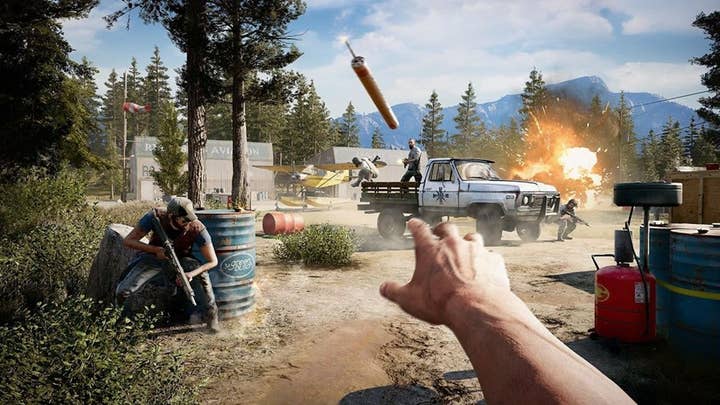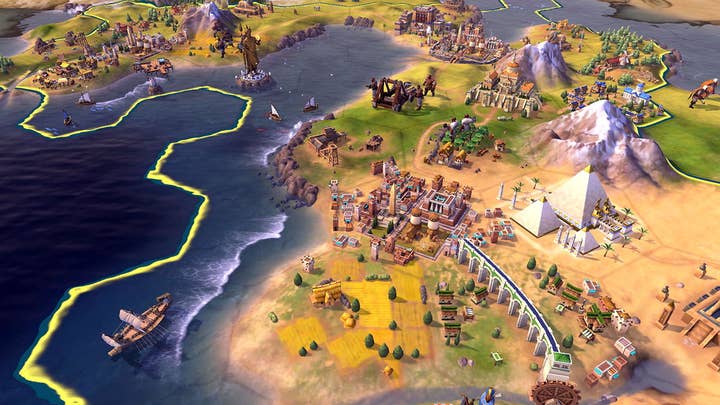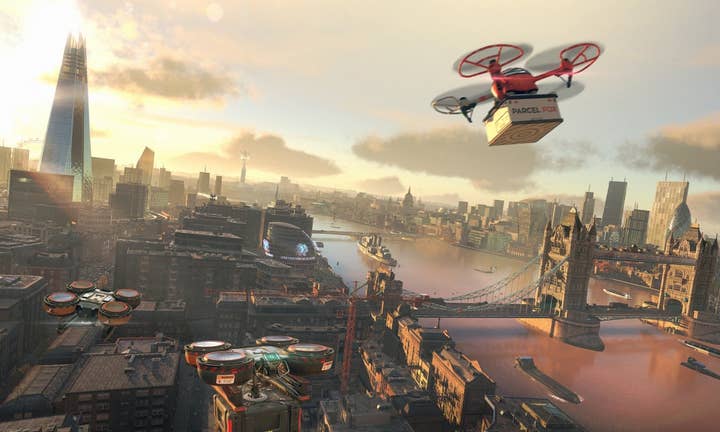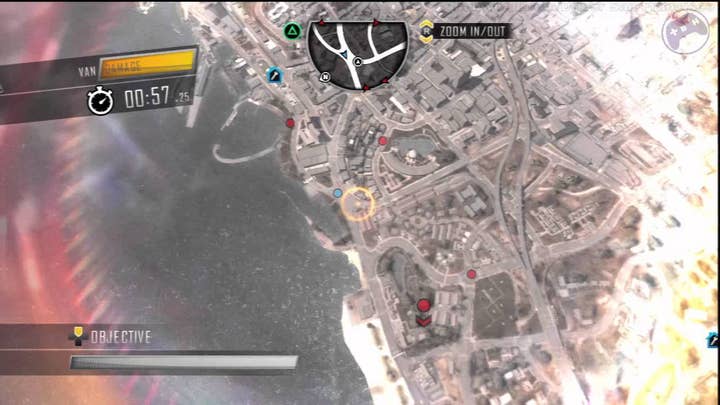"The time is right to re-evaluate open worlds. We can do better"
In his Develop:Brighton talk, Ubisoft Reflections' Chris Jenner suggested ways to achieve world-scale emergent gameplay
From Assassin's Creed Valhalla to the upcoming Cyberpunk 2077, open world games are becoming larger and more complex, with developers devoting more and more time and resources to ensuring they are populated with activities and engaging events for players.
And yet, as Ubisoft Reflections programmer Chris Jenner observed during his recent Develop:Brighton talk, many players still complain that both the worlds and their interactions with them feel empty.
"Modern action games are great at providing complex and detailed representations of player interactions with locations within the world," he said. "But this depth disappears when players move from one place to another. The new locations are pristine and returning somewhere normally means the effects of previous actions have been removed, as if they had never happened.

"The stories that drive our players forward through the world tend to be linear narratives, and the players must move through the world to find the opportunities to move that narrative forward by performing particular actions. This naturally means that these interactions are pre-planned, heavily scripted and limited in number."
He observed that while most games of this type add replayable challenges, side quests, random events and other activities to make the world feel less empty, these are often unconnected from the main story and can therefore feel unnecessary.
"As we move into a new console generation and begin to access the power of cloud computing, the time is right to re-evaluate open world games," he said. "We can do better, and create worlds that change in response to player actions. We should make the world itself a vital part of the gameplay experience."
The importance of emergent gameplay
Emergent gameplay -- where events that transpire are unique to each player's experience because they're based on their actions -- is "vital to the sandbox feel of many games," Jenner said.
"As we move into next-generation consoles and greater processing power from the cloud, the time is right to allow deeper interaction with our large-scale worlds"
He pointed to the NPCs in Far Cry as an example, specifically how they react to not only the player's actions, but also NPCs from other factions, wild animals and even fire. This "leads to a truly chaotic effect, where a small change in initial conditions can lead to a dramatically different outcome."
There is a different flavour of emergent gameplay, however, that open world action game developers should draw on, Jenner said -- and that's from large-scale strategy games like Civilization.
In such titles, the entire world changes over time based on both player and AI actions, which need to be planned, and their effects. While open world games tend to focus on minute-to-minute gameplay, these titles can enable unique experiences over several hours. Players often need to consider actions that won't pay off until much later in the match.
"Each game is different in ways that are hard to predict due to the complex interactions between the different combinations of static and dynamic entities in the game," said Jenner.

"Strategy and simulation games show us that emergent gameplay can come from world systems when we allow the actions to have persistence over longer time spans and direct the actions of our NPCs with a high-level plan. If we could realise similar systems within an open world game, we would get a world that changes and adapts to the actions of players, presenting new challenges and opportunities to the player each time they enter the world."
Jenner's proposal is that the small-scale simulations that create local emergent gameplay for players are tied to larger, world-scale simulations so that actions persist. Returning to an area players have visited before, for example, would reflect what happened when they were last there.
But how can this be accomplished? To explore this, Jenner compared the different requirements for simulation in open world action titles and large-scale strategy games.
Open world games
Jenner defined small-scale open worlds as ones that are limited to a smaller area, where players interact with several NPCs which react to their actions and to each other.
"Strategy and simulation games show us that emergent gameplay can come from world systems when we allow the actions to have persistence over longer time spans"
In such worlds, the simulation has to be responsive and accurate because the results are directly visible to players. The emergent gameplay in these instances stems from different game systems that work together to create a dynamic, unpredictable environment. However, having a large number of systems makes the world more complex as each system needs to constantly evolve.
AI, for example, needs to understand the world around it and make decisions on what to do next, driven by the actions of the player, other AI and static objects in the world. The AI drives animation and the current animation state feeds back into the AI, controlling what actions and animations are possible. The physics system feeds into the animation and AI, preventing characters from penetrating the static world and performing raycasts to determine which elements are currently visible. Other systems work alongside these and feed into them and each other.
This simulation can be expensive in terms of CPU usage, as each system has to update in real-time. That cost increases as the number of entities at play rises, which limits the number of active objects you can have in a particular area.
This also makes it impossible to load the data for the entire world at any one time, with developers instead only loading data for in the area immediately around the player. It creates what Jenner referred to as a "simulation bubble", spawning characters around the player and deleting them as the player leaves.
It means actions in a simulation bubble "have no real meaning" -- when the player leaves and the NPCs get deleted, the effects of their actions are also removed and the world resets to its default state. Even the background characters generally serve no purpose other than to fill the world for the player.

Large-scale simulation
Meanwhile, strategy and simulation games often show the entire world on a single map. Individual units are often quite simple -- a farm produces food, a soldier can perform a limited number of actions -- but the game as a whole is more complex.
"The possibilities are endless for finding ways that players could interact in shared, evolving worlds, where the environment changes - even when players are not involved"
More importantly, the large number of units and the persistence of their actions means no two matches play out in the same way. The state of the world and even its appearance can change dramatically as one side gains dominance. The fact that opponents have their own complex plans leads to a different kind of emergent gameplay.
"Players have to continually change and adapt their plans in response to new threats appearing or old ones disappearing as the balance of power changes," Jenner said.
However, those changes to the world are less frequent than in an action game, often triggered by a turn-based system. Once the player or AI give their orders, events play out according to the rules of the game.
The main complexity for developers in this type of game is ensuring the AI is strong enough to provide a challenging opponent. The AI should select the best possible orders for a large set of units, in theory in an attempt to win the game.
Bringing large-scale simulation to open worlds
Jenner offered several suggestions on how techniques from strategy games like Civilization, or even other genres, could be used to add more meaning and persistence to player actions in open world titles.
The key factor is reducing the CPU usage cost in order to track more entities, or at least do so in a way that doesn't significantly add to that cost. One suggestion was that rather than deleting NPCs or other entities not visible to the player, a much simpler simulation model could run in the background.

"We can drop the animation, physics and complex AI for controlling the systems [behind an NPC]," Jenner said. "We would need to retain a set of data describing the high-level state of the character -- its position, inventory, appearance and so on -- and operate on that data with a simplified set of code."
Meanwhile, interactions between players and the environment could be described with a set of simple logical rules, rather than complex simulation. Jenner added: "This can go a long way to fixing our CPU and data bottlenecks as the simplified systems can be lightweight and only access permanently loaded data."
He added that low level of detail (low LOD) NPCs running in the background would have to be updated less frequently than their high LOD counterparts in the player's vicinity. Depending on the game and the world systems being simulated, these NPCs could also be combined into a single low LOD entity when not on screen. Jenner offered the example of military units in strategy games, which are depicted as several individual soldiers when in high LOD, but as a single object that records a count of how many soldiers it includes when in low LOD.
"There is a way we can avoid simulation entirely by describing a dynamic world with a static set of data"
"There is a way we can avoid simulation entirely by describing a dynamic world with a static set of data," Jenner continued.
He referred to a technique used in Reflections' 2011 title Driver: San Francisco to describe the motion of all civilian traffic. Thousands of cars followed pre-planned routes that were laid out in a way so they wouldn't collide with each other. When cars were near the player, real vehicles were spawned that followed deterministic paths. When the player was far away, this data didn't need to be touched at all, but the cars were still moving around because time was passing.
This proved to be very cheap in terms of CPU usage. Thousands of vehicles could move without the need for AI, collision detection, or vehicle simulation codes.
"The problem with applying this approach to interactive world simulation is that deterministic entities can't react to anything," Jenner acknowledged. "Their movements are planned before the game even begins."
In Driver, Reflections handled this by deleting deterministic vehicles and replacing it with a more traditional AI-controlled one as and when needed. This essentially created a semi-deterministic simulation where NPCs were running in the background, but were updated with players actions.
"If the player was involved in a gunfight nearby, but not close enough for the NPCs to be promoted to high LOD, we could send messages to all the NPCs in the area and give them a chance to update their deterministic AI state in response to the new information," Jenner explained. "If that changed the behaviour of the NPCs, they could calculate a new deterministic path and start moving to a different target location.
"This approach is an extreme example of reduction in update frequency. Although each update can be expensive, we can leave entities untouched for minutes at a time as they deterministically play out the actions they want to perform."

Cloud-powered worlds
Jenner acknowledged that adding large scale simulation to open world action does still require more processing power -- and one option for gaining this is to use the cloud. Since semi-deterministic datasets change so infrequently, a low-bandwidth connection can provide accurate simulation information for many thousands of entities.
"We can do better, and create worlds that change in response to player actions. We should make the world itself a vital part of the gameplay"
"The cloud would be an ideal place to update our low LOD, large-scale situation and we could then feed that data into the player's computing for the processing of the high LOD simulation," said Jenner.
"Cloud computing would allow our large-scale complex simulations to be persistent and also make them accessible to many players at once. The possibilities are endless for finding ways that many players could interact in shared, evolving worlds, where the world itself acts to change the environment -- even when players are not directly involved."
Jenner pointed to companies such as Improbable and Hadean, who are actively working on solutions to allow this sort of cloud-powered large-scale simulation.
Re-evaluating open world games
This is just the tip of the iceberg, of course. While implementing these suggestions would enable the creation of more persistent worlds, this creates more challenges for other areas such as narrative, level design and art production, all of which would have to adapt to make the most of the strengths offered by world-scale emergent gameplay.
But Jenner posits that embracing this is the key to refreshing the open world genre.
"Moving the world itself to the heart of our gameplay will bring benefits to the player in terms of variety and cohesion of experience, and in adding significance to the choices that are made," he said. "Truly living worlds will not feel empty and lifeless. We can add this depth without sacrificing the emergent experience that comes from detailed small-scale simulation.
"As we move into the world of next-generation consoles and greater processing power from the cloud, the time is right for us to give more to players but allowing deeper interaction with our large-scale worlds."
You can watch Jenner's full talk below:









